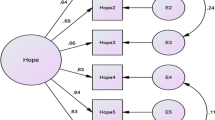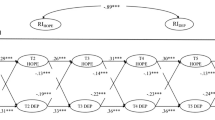Abstract
The overarching aim of the study was to investigate the relationship between hope and life satisfaction among a sample of children in Cape Town, South Africa. More specifically, the study aimed to ascertain the moderating effect of socio-economic status on this relationship. The study uses secondary data from the first wave of the Children’s Worlds study. A cross-sectional survey design was employed with the use of stratified random sampling to select a sample of 1004 twelve-year old children attending primary schools within the Cape Town Metropole. The questionnaire administered, incorporated Huebner’s (School Psychology International, 12, 231–240, 1991) Students’ Life Satisfaction Scale and Snyder et al.’s (Journal of Pediatric Psychology, 22, 399–421, 1997) Children’s Hope Scale. Data were analysed by means of correlational analysis, and using the Process Tool for moderation. The results indicate that there is a significant relationship between hope and life satisfaction for both low and middle socio-economic status communities. It was also revealed that socio-economic status does not moderate the relationship between hope and life satisfaction. It is recommended that further exploration be conducted on the influence of SES on the relationship between hope and life satisfaction. Given that the current study found that SES does not moderate the relationship between hope and life satisfaction, it is recommended that future studies explore the role of SES as a possible mediator.

Similar content being viewed by others
References
Adams, S., & Savahl, S. (2017). Children’s Discourses of Natural Spaces: Considerations for children’s Subjective Well-Being. Child Indicators Research, 10(2), 423–446.
Adler, A., & Seligman, M. E. (2016). Using wellbeing for public policy: Theory, measurement, and recommendations. International Journal of Wellbeing, 6(1).
Baron, R. M., & Kenny, D. A. (1986). The Moderator-Mediator Variable Distinction in Social Psychological Research: Conceptual, Strategic, and Statistical Considerations. Journal of Personality and Social Psychology, 51(6), 1173–1182.
Bosch, A., Roussouw, J., Claassens, T., & du Plessis, B. (2010). A Second Look at Measuring Inequality in South Africa: A Modified Gini Coefficient. School of Development Studies, Working paper (58). University of Kwazulu-Natal.
Bradley, R. H., & Corwyn, R. F. (2002). Socioeconomic status and child development. Annual Review of Psychology, 53(1), 371–399.
Bronk, K. C., Hill, P. L., Lapsley, D. K., Talib, T. L., & Finch, H. (2009). Purpose, hope, and life satisfaction in three age groups. Journal of Positive Psychology: Dedicated to furthering research and promoting good practice, 4(6), 500–510.
Camfield, L., Streuli, N., & Woodhead, M. (2008). Children’s Well-being in Contexts of Poverty: Approaches to Research, Monitoring and Participation. Young Lives, 12, 1–27.
Casas, F. (2011). Subjective social indicators and child and adolescent well-being. Child Indicators Research, 4(4), 555–575.
Casas, F., & Rees, G. (2015). Measures of children's subjective well-being: analysis of the potential for cross national-comparisons. Child Indicators Research, 8(1), 49–69.
Casas, F., Tiliouine, H., & Figuer, C. (2014). The Subjective Well-being of Adolescents from Two Different Cultures: Applying Three Versions of the PWI in Algeria and Spain. Social Indicators Research, 115, 637–651.
Diener, E., & Diener, M. (1995). Cross-cultural correlates of life satisfaction and self-esteem. Journal of Personality and Social Psychology, 68, 653–663.
Diener, E., Horwitz, J., & Emmons, R. A. (1985). Happiness of the very wealthy. Social Indicators Research, 16(3), 263–274.
Diener, E., Lucas, R. E., & Oishi, S. (2002). Subjective well-being. Handbook of positive psychology, 63–73.
Diener, E., Ng, W., & Tov, W. (2008). Balance in life and declining marginal utility of diverse resources. Applied Research in Quality of Life, 3(4), 277–291.
Dolan, P., Peasgood, T., & White, M. (2008). Do we really know what makes us happy? A review of the economic literature on the factors associated with subjective well-being. Journal of Economic Psychology, 29, 94–122.
Easterlin, R. A. (1974). Does economic growth improve the human lot? Some empirical evidence. Nations and households in economic growth, 89, 89–125.
Easterlin, R. A. (2013). Happiness, growth, and public policy. Economic Inquiry, 51(1), 1–15.
Engelbrecht, G. J. (2011). The performance of hope: The social construction of self-stories embedded in God-stories in the context of a short-term rehabilitation programme for addiction. Submitted in accordance with the requirements for the degree of Doctor in Theology: University of South Africa.
Field, A. (2013). Discovering statistics using IBM SPSS statistics (4 th .ed). Los Angeles: Sage Publications.
Forgeard, M. J., Jayawickreme, E., Kern, M. L., & Seligman, M. E. (2011). Doing the right thing: Measuring wellbeing for public policy. International Journal of Wellbeing, 1(1), 79–106.
Frisch, M. B. (2000). Improving mental and physical health care through quality of life therapy and assessment. In E. Diener & D. R. Rahtz (Eds.), Advances in quality of life theory and research (pp. 207–241). Dordrecht, Netherlands: Kluwer Academic Press.
Gilman, R., & Huebner, E. S. (2006). Characteristics of adolescents who report very high life satisfaction. Journal of Youth and Adolescence, 35, 311–319.
Hall, K., Woolard, I., Lake, L., & Smith, C. (2012). Children and inequality: Closing the gap. South African Child Gauge. Cape Town: Children’s Institute.
Headey, B., Muffels, R., & Wooden, M. (2008). Money does not buy happiness: or does it? A re-assessment based on the combined effects of wealth, income and consumption. Social Indicators Research, 87, 65–82.
Huebner, E. S. (1991). Initial development of the Students' Life Satisfaction Scale. School Psychology International, 12, 231–240.
Huebner, E. S., & Gilman, R. (2003). Toward a focus on positive psychology in school psychology. School Psychology Quarterly, 18(2), 99–102.
Huebner, E. S., Suldo, S. M., Smith, L. C., & McKnight, C. G. (2004). Life satisfaction in children and youth: Empirical foundations and implications for school psychologists. Psychology in the Schools, 41, 81–93.
Isaacs, S. A., & Savahl, S. (2014). A qualitative inquiry investigating adolescents' sense of hope within a context of violence in a disadvantaged community in Cape Town. Journal of Youth Studies, 17(2), 269–278.
Jones, J. L. (2011). Adolescent well-being in West Africa: Subjective well-being of adolescents in Cote d’Ivoire. Tulane University, Louisiana, United States of America: Unpublished doctoral dissertation.
Lopez, S. J., Ciarlelli, R., Coffman, L., Stone, M., & Wyatt, L. (2000). Diagnosing for strengths: On measuring hope building blocks. In C. R. Snyder (Ed.), Handbook of hope: Theory, measures, and interventions (pp. 57–85). San Diego: Academic Press.
Lopez, S. J., Rose, S., Robinson, C., Marques, S., & Pais Reibero, J. (2009). Measuring and promoting hope in schoolchildren. In R. Gilman, E. S. Huebner, & M. Furlong (Eds.), Promoting wellness in children and youth: Handbook of positive psychology in the schools (pp. 37–51). Mahwah, New Jersey: Lawrence Erlbaum.
Lyubomirsky, S., King, L., Diener, E. (2005). The Benefits of Frequent Positive Affect: Does Happiness Lead to Success? Psychological Bulletin, 131(6), 803–855.
McAuley, C., McKeown, C., Merriman, B. (2012). Spending time with family and friends: children's views on relationships and shared activities. Child Indicators Research, 5(3), 449–467.
Marques, S.C., Pais-Ribeiro, J.L., Lopez, S.J. (2011). The role of positive psychology constructs in predicting mental health and academic achievement in children and adolescents: A two-year longitudinal study. Journal of Happiness Studies, 12(6), 1049–1062. https://doi.org/10.1007/s10902-010-9244-4.
Mason, J., & Hood, S. (2011). Exploring Issues of Children and Actors in Social Research. Children and Youth Services Review, 33(4), 490–495.
Merkaš, M., & Brajša-Žganec, A. (2011). Children with different levels of hope: Are there differences in their self-esteem, life satisfaction, social support, and family cohesion? Child Indicators Research, 4, 499–514.
Nowicki Jr. S., & Strickland, B.R. (1973). A locus of control scale for children. Journal of Consulting and Clinical Psychology, 40, 148–154.
Park, N., & Peterson, C. (2006). Character strengths and happiness among young children: Content analysis of parental descriptions. Journal of Happiness Studies, 7, 323–341.
Pavot, W., & Diener, E. (2013). Happiness experienced: The science of subjective well- being. Oxford handbook of happiness, 134.
Peiró, A. (2006). Happiness, satisfaction and socio-economic conditions: some international evidence. Journal of Socio-Economics, 35, 348–365.
Proctor, C. L., Linley, P. A., & Maltby, J. (2009). Youth life satisfaction: A review of the literature. Journal of Happiness Studies, 10, 583–630.
Savahl, S., Isaacs, S., Adams, S., Carels, C. Z., & September, R. (2013). An exploration into the impact if exposure to community violence and hope on children's perceptions of well-being: A South African Perspective. Child Indicators Research, 6(3), 579–592.
Savahl, S., Adams, S., Isaacs, S., September, R. L., Hendricks, G., & Noordien, Z. (2015). Subjective well-being amongst a sample of children in the Western Cape region of South Africa: A descriptive study. Child Indicators Research, 8(1), 211–226.
Savahl, S., Casas, F., & Adams, S. (2016). Validation of the Children’s Hope Scale amongst a sample of adolescents in the Western Cape region of South Africa. Child Indicators Research, 9(3), 701–713.
Savahl, S., Casas, F., & Adams, S. (2017a). Children’s subjective well-being: Multi-group analysis among a sample of children from two socio-economic status groups in the Western Cape, South Africa. Child Indicators Research, 10(2), 473–488.
Savahl, S., Tiliouine, H., Casas, F., Adams, S., Mekonen, Y., Dejene, N., Benninger, E., & Witten, H. (2017b). Children's subjective well-being in Africa: A comparative analysis across three countries. Children and Youth Services Review, 80, 31–40.
Snyder, C. R. (1994). The psychology of hope: You can get there from here. New York: Simon & Schuster Inc..
Snyder, C. R. (1995). Conceptualizing, measuring, and nurturing hope. Journal of Counselling and Development, 73, 355–360.
Snyder, C. R. (2002). Hope theory: Rainbows in the mind. Psychological Inquiry, 13, 249–275.
Snyder, C. R., Hoza, B., Pelham, W. E., Rapoff, M., Ware, L., Danovsky, M., & Stahl, K. J. (1997). The development and validation of the Children’s Hope Scale. Journal of Pediatric Psychology, 22(3), 399–421.
Statistics South Africa (2015). General Household Survey. Statistics South Africa: Pretoria.
Stevenson, B., & Wolfers, J. (2008). Economic growth and subjective well-being: Reassessing the Easterlin paradox (No. w14282). National Bureau of Economic Research.
Van Praag, B. (2011). Well-being inequality and reference groups: an agenda for new research. The Journal of Economic Inequality, 9(1), 111–127.
World Bank. (2012). Annual Report 2012. World Bank.
Acknowledgments
The authors would herewith like to acknowledge the Jacobs Foundation for institutional and financial support.
Author information
Authors and Affiliations
Corresponding author
Rights and permissions
About this article
Cite this article
Raats, C., Adams, S., Savahl, S. et al. The Relationship Between Hope and Life Satisfaction Among Children in Low and Middle Socio-Economic Status Communities in Cape Town, South Africa. Child Ind Res 12, 733–746 (2019). https://doi.org/10.1007/s12187-018-9549-0
Accepted:
Published:
Issue Date:
DOI: https://doi.org/10.1007/s12187-018-9549-0




